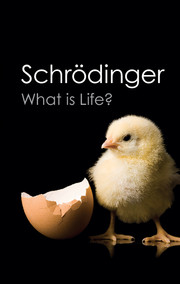Book contents
- Frontmatter
- Contents
- WHAT IS LIFE?
- Foreword
- Preface
- 1 THE CLASSICAL PHYSICIST'S APPROACH TO THE SUBJECT
- 2 THE HEREDITARY MECHANISM
- 3 MUTATIONS
- 4 THE QUANTUM-MECHANICAL EVIDENCE
- 5 DELBRÜCK'S MODEL DISCUSSED AND TESTED
- 6 ORDER, DISORDER AND ENTROPY
- 7 IS LIFE BASED ON THE LAWS OF PHYSICS?
- EPILOGUE ON DETERMINISM AND FREE WILL
- MIND AND MATTER
- Autobiographical Sketches
1 - THE CLASSICAL PHYSICIST'S APPROACH TO THE SUBJECT
Published online by Cambridge University Press: 05 September 2014
- Frontmatter
- Contents
- WHAT IS LIFE?
- Foreword
- Preface
- 1 THE CLASSICAL PHYSICIST'S APPROACH TO THE SUBJECT
- 2 THE HEREDITARY MECHANISM
- 3 MUTATIONS
- 4 THE QUANTUM-MECHANICAL EVIDENCE
- 5 DELBRÜCK'S MODEL DISCUSSED AND TESTED
- 6 ORDER, DISORDER AND ENTROPY
- 7 IS LIFE BASED ON THE LAWS OF PHYSICS?
- EPILOGUE ON DETERMINISM AND FREE WILL
- MIND AND MATTER
- Autobiographical Sketches
Summary
Cogito ergo sum.
descartesTHE GENERAL CHARACTER AND THE PURPOSE OF THE INVESTIGATION
This little book arose from a course of public lectures, delivered by a theoretical physicist to an audience of about four hundred which did not substantially dwindle, though warned at the outset that the subject-matter was a difficult one and that the lectures could not be termed popular, even though the physicist's most dreaded weapon, mathematical deduction, would hardly be utilized. The reason for this was not that the subject was simple enough to be explained without mathematics, but rather that it was much too involved to be fully accessible to mathematics. Another feature which at least induced a semblance of popularity was the lecturer's intention to make clear the fundamental idea, which hovers between biology and physics, to both the physicist and the biologist.
For actually, in spite of the variety of topics involved, the whole enterprise is intended to convey one idea only – one small comment on a large and important question. In order not to lose our way, it may be useful to outline the plan very briefly in advance.
Information
- Type
- Chapter
- Information
- What is Life?With Mind and Matter and Autobiographical Sketches, pp. 3 - 18Publisher: Cambridge University PressPrint publication year: 2012
Accessibility standard: Unknown
Why this information is here
This section outlines the accessibility features of this content - including support for screen readers, full keyboard navigation and high-contrast display options. This may not be relevant for you.Accessibility Information
- 1
- Cited by
